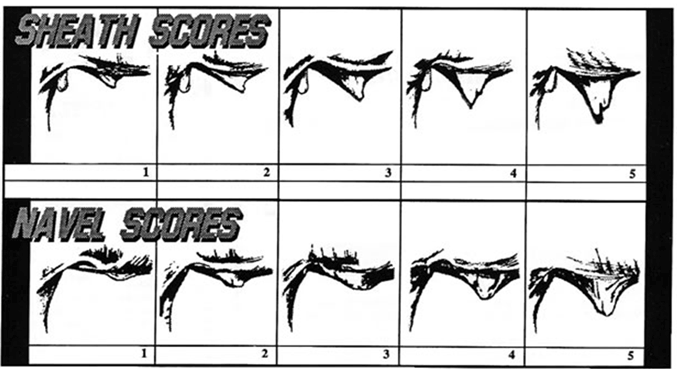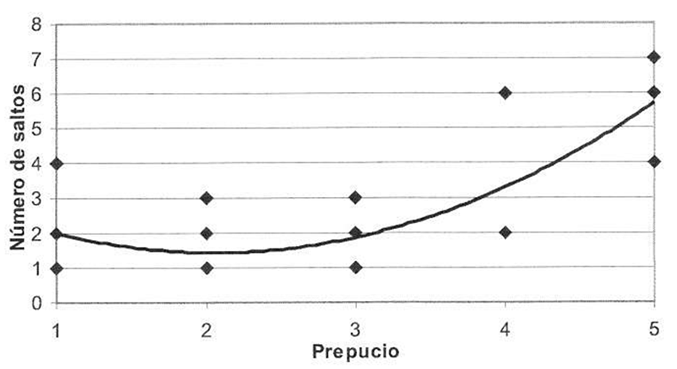Another reason for buying clean sheathed Brangus and Ultrablack bulls
It takes two to tango to gain high breeding levels in a herd- a prolific, fertile sire and a fertile, cycling cow. However when you consider a bull is going to be working at a ratio of 1-40 breeding age females it reinforces the importance of a bull’s libido and fertilising ability. The ability of a bull to get lots of calves is a critical factor in herd fertility and its consequent effect on weaning rate, and all stops should be out to ensure fertile bulls are used.
A veterinary bull breeding soundness evaluation is a “must-do” before the mating season when structural soundness is assessed amongst other things. Part of soundness evaluation is assessment of the sheath size and shape.
It seems like common-sense to select against bulls with pendulous sheaths but for whatever reason I am still seeing an unnacceptable frequency of bad sheaths as I wander around industry. It’s in Brahmans and Brahman-derived breeds that the highest incidence occurs.
Sheath genetics
Sheath score in males and navel score in females is under genetic control with heritabilities from 25-45%, so they are moderately heritable; navel score being a correlated though slightly different trait to sheath score. It’s heritability being moderate means that we can make favourable changes in a breeding program by selecting for a better sheath & navel shape in replacement animals.
Sheath scores
Bulls with sheaths scores graded 1-3 are acceptable. Scores 4 and 5 are not, and you should not be using bulls with those scores in your bull battery.

Consequences of Scores 4 & 5 and sheath shape
Bulls with scores 4 & 5 may be predisposed to serious prolapse or preputial damage from physical factors like sticks or tussock grass normally resulting in the end of the bull’s effective breeding life in an extensive operation. Some of these bulls with pendulous sheaths also have a very thick residue of the umbilicus (navel) which is associated with a large inverted fold of skin referred to as the ‘rosette (J. Bertram pers. comm.). Both of these conditions appear to limit the bulls’ ability to serve cows.
Most producers would identify with the possibility of preputial damage occurring and preputial prolapse developing in bulls with those pendulous sheaths, but I’m not sure people identify with the pendulous sheath causing problems for a bull in serving a cow.
Serving ability
Bulls with sheaths scored 1 to 3 all have their sheath and (of course) the penis pointing forward. Scores 4 and 5 have their sheath and therefore the penis pointing down. Obviously everything changes with sexual stimulation and erection but bulls with grade 4 and 5 scores usually seem to have less control and they start from a different position. They need to be more excited to point the penis in the right direction (L. Turner pers. comm.). You can understand why score 4/5 bulls could become very frustrated especially after multiple jumps without completing a serve.
Recent research in Argentina
A recent research study by INTA (National Ag. Research organisation) researchers Lopez Valiente and colleagues, from Northern Argentina, compared sheath score with serving ability in Braford bulls is of great interest. All bulls’ sheaths were scored using the 1-5 system. The numbers involved are not huge but the results from the 46 bulls are of interest. The bulls entered the restrained cows in an adjacent yard in pairs.
The researchers counted how many mounts it took for each bull to complete a serve.
A bull completed his turn when a successful serve and ejaculation was completed.
A bull that could not complete a serve in 4 mounts was rested for 15 minutes.

Their graphic above shows the number of mounts (saltos) to complete a serve, on the vertical axis. Sheath (prepucio) score is then shown on the horizontal axis.
They found that the more pendulous the score (>3), the more mounts it took the bull to complete the serve.
The Argentinean researchers concluded that Bos indicus and Bos-indicus-derived breed societies were correct in recommending against bulls with scores 4 and 5. They also suggested that if people buy bulls with 4 or 5 sheaths they should be prepared to accept poorer fertilising rates or alternatively boost the bull percentage.
Australian work:
The evidence from Australia research is much less clear-cut but there are some indications that tend to support the Argentinean work. Bertram and colleagues (2002) found in 3-year-old Santa Gertrudis bulls that serves and mounts + serves were negatively correlated with navel score. More work is needed though given the importance of fit and prolific bulls to herd profits.
Conclusions
In Brahman and Brahman-derived breeds, bulls with sheath scores from 1-3 should be selected as replacements and scores 4 & 5 rejected.
Bull buyers that ignore that advice may find a greater bull breakdown % from prepuce damage or prolapse, leading to significant extra bull costs and reduction in herd fertility.
But more seriously for the industry (L. Turner pers. comm.), the reduction in the ability to keep performing during the mating season could be a much greater (but less obvious) problem than any increase in preputial prolapse.
